- 6754 E. Wilson St., Fountain, NC 27829
- 252.749.3228
- My Account
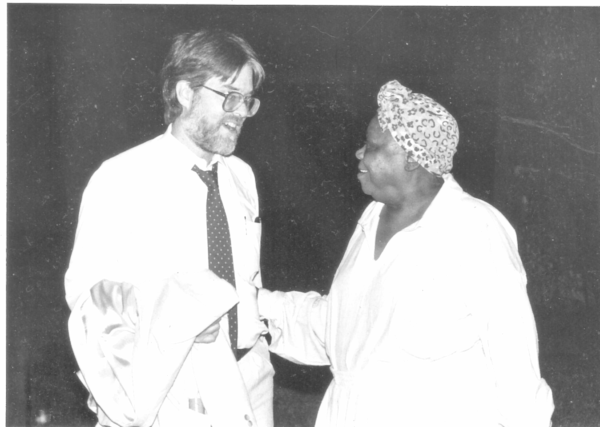

A chronological memoir of sorts, ongoing since pandemic time started me on emptying boxes collected and carted around from place to place over the years it took to finally get to Fountain–sorting the accumulations of a life of reluctance to contribute to landfills.
1951 Graham
A Square Miler born April 20 and subsequently grew up in Graham, the second of four children (Anne, born 1946; Jane, 1955; Jim, 1960) of Iva Ruth Buckner of Graham and James Alexander Albright of Mebane. Although born in Burlington, at Alamance General Hospital, I was given dispensation by Jack Henderson so that I, my siblings, and others of our generation could claim Square Miler status, a distinction that previously had required one to be born and reared within a square mile of the Alamance County courthouse. Our generation of hospital born babies, then, would only need to be reared within that space for such an honor, which could only be bestowed by Mr. Jack.
These days, though, for $3 you can buy a sticker (not from us) that says you’re a Square Miler.
And Graham, they say, is the new Mebane, which once was the new Hillsborough. The Graham court square–one of the original roundabouts in North Carolina–is still bustling, still dominated by its Confederate soldier looking North for Yankees (and the focal point, in the summer and fall of 2020, for frequent Black Lives Matter protests) that come these days from every direction. When I go home, one of the few places that’s still the same, it seems, is Jim’s Tastee-Freez. And one of the best new places is a Christian bookstore, Things Above, opened in early 2020 by my sister Jane on the northwest quadrant of court square, near where our grandfather, James M. Buckner, used to have his justice of the peace office.
1968 Graham
As the school year ended, so did our Jim Crow lives. Graham High School had had three African American students in the three years I had attended, and in the fall of 1968 we would experience court-ordered full integration. Robert Canady had entered as a senior when I was a freshman, recruited from Central Alamance, the consolidated school for African-American students in Alamance County, by our basketball coach, Herb Hawkes. I know nothing of what Robert went through that year, but I remember being surprised at how a ball player so clearly the best on our team could so nervously screw up during a game. What I’d have done in a gym full of black players, fans, and referees, with me the only white boy there, I never contemplated; but at practice, when it was just us, jayvees and varsity running scrimmages, he was always a show, always the strongest rebounder, impossible to stop on a drive to the hoop or with a quick pull-up jumper. At any rate, we were all white again my sophomore year, before my junior year when two brave young women, Brenda Foust and Jessie Warren, transferred from Central Alamance to attend Graham High for their senior year. Of their treatment, I remember very little but for the mean graffiti that would show up on walls from time to time. It would be many years before I’d begin to realize what all must have gone on to get Brenda and Jessie to embark on this perilous adventure–and even still I can only imagine: were there other kids considered for this “honor,” and why did they pull out–what threats might have been made here, like throughout the South when white communities felt threatened by blacks wishing to vote or go to an integrated school? Why were none selected for the previous year? What kinds of deals and promises? Under the list of “senior accomplishments” in our school annual that year, both were noted only for their “transfer from Central Alamance, 4,” their previous years of accomplishments disappeared completely. Did they refuse to fill out the senior statistics form? Were they even asked to do so?
Meanwhile, I had the best summer job ever, operating a summer “open gym” for locals, and it was here I met Jody Hooker, who’d turn out to be leading scorer on our coming year’s basketball team. I had grown up on the white side of McAden Street, Jody, just a block away, on its other side, but we hadn’t met until that summer. He had such a sweet jump shot that it was difficult to ever take one of my own, and we looked forward to our first year of playing on a team together, with coach Hawkes, who had been quick to embrace the idea of integration and was excited to see the nucleus of our team working out together on a regular basis at the gym I ran, a couple of blocks from home. “Running the gym” meant, really, playing pick-up games pretty much non-stop all day, and sometimes having one of the local twins, Ronald or Donald, retrieve balls during my free-throw practicing.
Then, in August, just before school was to start, coach Hawkes stopped by our house and had a brief and very serious conversation with my father, in our driveway. He had been told by our new superintendent that he would keep his job for the coming year as a drivers ed teacher but that his status as a coach was still uncertain; coaching was what he wanted to do, and he couldn’t stay without a guarantee; and he had been offered a coaching job in Greeneville, Tennessee; and he had accepted. My father reported that he had wanted to tell me all this in person but was too emotional to do so, and I watched him drive off in his VW bus, unaware that within moments I’d learn that he was no longer my coach, that I’d never see him again.
1969 Graham / Chapel Hill
I graduated from Graham High School: Top Ten senior, a Morehead Scholarship finalist, and captain of the Red Devils’ tennis and basketball (co-captain with Brad Evans, who went on to play basketball at North Carolina Central and was later elected to the Alamance / Burlington Schools Board of Education) teams. I was also president of the student body during Alamance County’s first year of integration, which, among other thing, wiped out high school sports records for both the white and African-American high schools. Alamance was one of two school systems in the state that used the local African-American high school after integration as its integrated high school.
I started summer school at Carolina a couple of days after high school graduation and began writing the “Ramblin’ Ram” column for the Tar Heel with the byline “Donovan Albright.” One of my English profs, B.O. Harder, complimented some poetry I’d submitted in a journal, calling my verse “Skeltonic,” which I had to look up.
In the fall, for the Daily Tar Heel, I covered fencing, gymnastics, and freshman football.
Steven Michael Allen, my high school best friend, committed suicide on September 27; he was 19. Someone came to my English 21 class, taught by Wallace Kaufman, to tell me to call home. At that point, Zeus was still alive at Duke Hospital but had died by the time Dickie Dixon drove me and other Graham friends from Carolina there.
Later in the semester, after Kaufman told us he was canceling class for the next session as he was going somewhere to present a reading, I asked him whose poems he would be reading. This small scene was after class, as he was gathering his books and notes to leave; he looked at me like I was a country-boy idiot (imagine that!) and said, “Mine, of course.” This was the first time I had thought of someone I might know as also being someone who could be a poet, and the last time I spoke to him.
In October, I was cut from the Carolina freshman basketball team and, early that afternoon, with my friend Jack Deason, hitchhiked to Greensboro to see Easy Rider at the Janus Theater. It would be a long time before I cut my hair.
1970 Chapel Hill
Fall semester, I pledged Tau Epsilon Phi along with my Graham Dorm roommate, Paul Steiger, and, likely because no one else wanted the “job,” served as pledge class president. These were not the glory years of the frat system but the house on Rosemary Street with a private room sure beat dorm life–excellent cooks and plenty of folks to play hearts or spades with until the Durham Morning Herald arrived: “the bulldog’s here,” someone would announce, sometime around 4:30 a.m. I’m still embarrassed to recall over-sleeping Dr. Bain’s early afternoon class to which he’d brought his old friend Mario Puzo to visit; we were to have read The Curious Pilgrim for the day’s assignment, and I hadn’t.
Outside my first floor room was our basketball court, and the room next to mine was James Hunter’s. He was part of a Durham crowd (noted in part for their rock n roll Thanksgiving parties) that I hung with some, and James and I became good friends–took a few road trips together and I was awakened most mornings to his copy of Neil Young’s Harvest blasting, “Think I’ll pick it up and pack it in.” Things went bad for James and he bought a one-way ticket to Philadelphia where he committed suicide in a hotel room. I was playing tennis in Graham the day Paul Steiger stopped by to tell me the news; James had been buried by then.
As part of my “entry” into a poetry writing class taught by Carolyn Kizer, we had to present her with a portfolio of our poetry and then go to her house to talk about the poems. Our conversation was short. She asked who my poetic influences were; I replied “Lawrence Ferlinghetti and Rod McKuen” (Ferlinghetti’s Coney Island of the Mind a gift from my sister Anne, and McKuen’s volumes favorites of my girlfriend Cathy Ray). As I recall, Kizer kept a straight face and gently recommended that I stop writing poems for a while, until I had absorbed some further influences.
Later, at a reception for her at Peter Makuck’s house in Greenville, I tried to tell her how smart that advice had been but she denied ever having said something like that to a student. I wanted to clarify that the poems were really bad (am pretty sure I burned them somewhere along the way), and I should not have been in the same room as the rest of the young poets, but the conversation in Peter and Phyllis’s kitchen drifted away. As the years passed, I would meet several of the poets who’d stayed in that class, all represented in an anthology of class writing: Robin Brewer, who would be my supervisor at Henry Thorpe & Associates; Tim Tarkington, who’d become one of my best friends at UNCG (and whose couch I’d live on for a period of my homelessness); Martha Mac Harris, from Mt. Gilead, my future wife’s best friend from childhood.
1972 Chapel Hill
A.B from UNC-CH, with a double-major in English and journalism.
Anxious to be out in the world, I managed a December graduation, moved back to Graham and began substitute teaching, and by March had my first real job.
1973 Graham / Rocky Mount
Worked as publications assistant at Henry Thorpe & Associates. Our clients were Hardee’s, City of Rocky Mount, Coastal Plains Insurance, and Carolina Enterprises. I got to interview Norman Rockwell on the phone, in a futile attempt to get him to sell to Hardee’s a painting that could be used on the cover of the annual report. The company got instead a blurred photo of me and a couple of others “hurrying on down to Hardee’s,” shot by our local contract photographer Charlie Killebrew.
Married Hilda Haithcock of Mount Gilead, at University Methodist Church in Chapel Hill, Rev. Langill Watson officiating. He had been our pastor for a large part of my MYF days at Graham’s First Methodist Church. I met Hilda on a blind date arranged by her double-first cousin, Sammy Haithcock, who lived on my dorm hall at Carolina. We honeymooned at the Watergate Hotel in D.C. and then at Ocean City.
Back home in Rocky Mount, I read the Washington Post daily as it reported on Nixon’s downfall. It arrived every morning at the nearby train station and a copy was delivered to our offices.
Working for 50 weeks to get a couple off didn’t seem like the way to go, so I started thinking about graduate school, an MFA, hoping to be somewhere else by January. U Mass, a top choice, didn’t have spring semester admissions, but Iowa, the other top one, accepted me. I got my student ID card and started subscribing to an Iowa City newspaper so I could shop for apartments. UNC-G had also accepted me, and when Hilda balked at leaving NC, it became an easy second choice. It would be many years–not until I was directing ECU’s little M.A. program in creative writing–before I’d realize I should probably have let someone at Iowa know that I wasn’t going to arrive.
Meanwhile, I drove to Chapel Hill once a week for an advanced fiction writing class that met in Louis Rubin‘s house and was co-taught by Max Steele. They seemed weekly to play good cop/bad cop, Rubin gruff and direct when he ran the workshop, Steele kind and inquisitive when it was his turn. Rubin made fun of someone saying a character had an “equine nose.” Steele told a great story about returning to Carolina after World War II unable to find a place to live, campus housing full with vets. He found for his home a fancy doll house in someone’s Carrboro yard. Once you got inside, he said, it was okay, so long as all you wanted to do was sit or lie down and, when lying down, you didn’t need to stretch out your legs. When Rubin told us in December that he would see us in January, I realized that it was a year-long course, not a semester-long one.
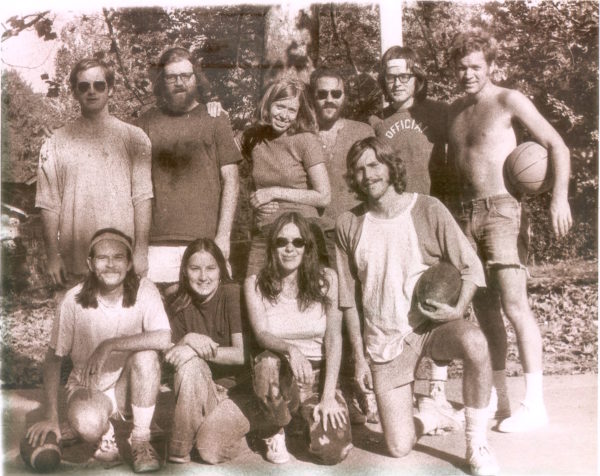
Sunday afternoon MFA basketball team, L to R, front row: Tim Tarkington, Mary Brownlee, Mary LeDonne, George Jarecke. Back row: Jim Driggers, Fam Brownlee, Lynne Barrett, Steve Makler, OfficialAA, Mike Riley. Photo by Hillary Masters
1974 Greensboro. Began graduate studies at UNCG. Hilda and I lived in a $50-a-month Walker Avenue apartment, a block off of Tate Street, where Liuza’s became one haunt, the Pickwick another. Then we lived apart, and I stayed in a series of sketchy apartments while working a part-time job first helping set up Waldenbooks in the newly constructed Four Seasons Mall, and then clerking in it, with Ray Johnson my boss.
1975 Greensboro
In December, I received my MFA from UNCG, in fiction writing. Not long before that expected graduation, Fred Chappell stopped me in the hall one day and said he wasn’t finding any record of my having taken a comprehensive exam. In an instant, I saw my graduation disappear into another semester of bills. I said I hadn’t taken such a thing and waited while he drew out the pause, and then said matter-of-factly, Well, type up a couple of pages on what has or hasn’t influenced your life and get it to me by tomorrow. As it turned out, because I had entered the program in January 1974, with no cohorts, I had missed the usual request for such a document that went out on first class of the fall semester. I typed up 500 words on Brewster McCloud and gave it to Fred the next day and he was able then to write in a date for my having successfully passed my comprehensives.
We had a regular Sunday afternoon basketball gathering that got photographed by visiting writer Hillary Masters in the spring of 1975: Tim Tarkington, whose Atlanta home has welcomed me and family many times over the years, often while we were in town for Braves games; Mary Brownlee; Mary LeDonne (Cassidy), who retired from the English Department at South Carolina State University, Orangeburg–I recognized her laugh (not heard in over 40 years!) at the memorial for Greensboro Jim Clark before she turned around and I saw that it was, indeed, she; George Jarecke, who became a lawyer; Jim Driggers, Fambrough Brownlee, Lynne Barrett, Steve Makler, and Mike Riley, who was on the English faculty teaching Shakespeare, I believe. I ran into Lynne and her husband at the only AWP meeting I ever attended, in Boston, and had a great time catching up at a UNCG-hosted reception before dashing off for a Celtics game; her terrific collection of south Florida stories Magpies remains one my favorites. Fam wrote a history of Winston-Salem that was published soon after we graduated and last I heard he was Forsyth County Public Library North Carolina Room Historian; not sure what happened to Jim, but I imagine somewhere he’s singing old Broadway show tunes with someone he loves.
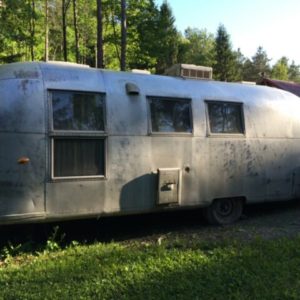
This looks like home to me
1975-76 Greensboro / Kernersville / Winston-Salem
I had by late 1975 moved into a little AirStream outside Kernersville, and I worked full-time in Winston-Salem as assistant manager to Waldenbooks in the new Hanes Mall. One evening I came home to find the heating system had malfunctioned and everything in it, including my portable electric Royal on which I was trying to type my thesis, was covered in soot.
1976-78 Gastonia
While working as manager at the Waldenbooks in the new Eastridge Mall, Hilda and I got back together, and living again with her and our two cats, Butch and Stymie, was a pretty good life. I won $100 on a bingo game at the local A&P, where I stopped once a day to buy a pack of Benson & Hedges Deluxe Menthol Ultra-Lights, had a couple of short stories published, and worked on turning my thesis into a novel.
In one way, this was a great job: I could order any book I wanted, it would come to Gastonia, and the bill would go to Stamford, CT. I stocked a complete line of books published by City Lights and Black Sparrow and had a lively little space and a great friend in Steve Smith, my smart and sardonic assistant manager. An English major at UVa, he and his wife, Phyllis, had moved to the area for a school teaching job she had accepted, and their daughter, Holly, was born there, before Steve took a district manager’s job with Waldenbooks and they moved to New Orleans. Steve and I made the short drive to Charlotte often for beers and pin ball. Gastonia was then a dry town, alcohol available only in private clubs; one of my temps took me to his, once: a concrete windowless block with a steel door and an eye-plate that could be slid open to verify who was wanting in.
1978-80 Athens, Georgia
Hilda’s dream was interior design and she got accepted into the University of Georgia’s program, so we moved to Athens, where I clerked at Barnett’s Newsstand a couple of doors up from the Varsity, which was across the street from the university campus and downstairs from the original 40 Watt Club. I went to a few B-52s rehearsals there, paying someone at the top of the stairs a beer and a dollar to hang out while the B’s worked on their songs.
I also worked as circulation manager for New Arts magazine, as a sports official calling football and basketball games for the Northeast Georgia Officials Association, tried selling blood but passed out, and wrote “The Weekly Reader” column of book reviews for the Athens Observer.
As a volunteer, I taught creative writing workshops at Clarke County Prison Camp in Athens, a “job” I secured with the assistance of my friend Thomas “Donkeyman” Bintz, who was an art instructor at CCPC. (Donkyman–now an artist who goes by the name of Captain Honk–also somehow managed to get Doc Watson to the prison camp for a concert.) He made a little money on football game days selling University of Georgia merchandise, including his original “Walker My Dog” bumpersticker; he and his burro, Bonita, displayed a sign that added each week the handpainted score of the previous week’s game. He also sold various Confederate-themed merchandise–Georgia at the time had a prominent seatbelt sign that many people thought suggested the Confederate battle flag.
1980 Graham / Greensboro / Cortona, Italy / New Orleans
We moved back to Graham in early 1980, and I got a sweet census job as Quality Crew Chief Supervisor, which allowed me to work from home, from where I traveled to collect completed forms from six regional Quality Crew Chiefs I’d hired.
Hilda also got a job with the census, working in Greensboro every day, and one day she didn’t come back to Graham. However, we’d already paid deposits on a summer abroad so went ahead to Italy with the University of Georgia’s Cortona program for five weeks, living in a 15th century monastery on a hill above town.
Upon our return to the states, she, newly graduated from U of Georgia, stayed in Greensboro, I in Graham, where I wrote a few sports articles for the Alamance News and then moved to New Orleans to look for work.
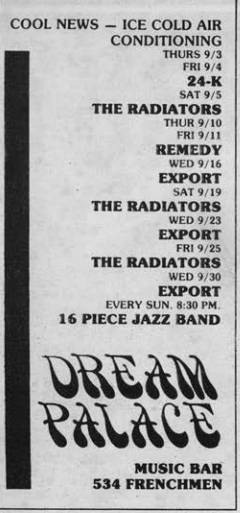
Wavelength, September 1981. scholarworks.uno.edu
1980-81 Metairie, Bourbon Street, & Chalmette, Louisiana
I taught English & U.S. History at Chalmette High School while living first with good friends Steve and Phyllis Smith (Steve had been my assistant manager at Waldenbooks, Gastonia) in Metairie and then for the rest of the school year at 1213 Bourbon St., a short walk away from the Mississippi River and Port o’ Call, Buster Holmes’, Snug Harbor, the Dream Palace (with its 12-ft alligator mounted behind the bar), Sweet Willie’s, Molly’s at the Market, the Abbey. . .
Meanwhile, back in Athens, the Georgia Bulldogs, led by Herschel Walker-my-dawg, plowed through their schedule to an undefeated season, and Donkeyman came to visit for their Sugar Bowl game against Notre Dame, which was to settle the national championship. He left Bonita home but brought his sign, which had grown to about 10′ tall with all those scores added to it weekly, and his merchandise. We set up shop outside the Superdome, where he did a good bit of early business, and I went to scout out a bar where we could watch the game. I found the place and returned. No Donkeyman, but his sign on the sidewalk. As I studied the sign and this scene, someone asked if I was looking for that longhaired dude with the bumperstickers and I said I was and he said the cops had taken him away.
At the satellite police station not far away, I learned it would cost $50 to get him out. I had $42 and some change; a guard made up the difference, laughed, and released him but not his merchandise: “You’ll see it in court.”
No money left between us. We stopped by the Fairmont, where my girlfriend B worked the desk. It was half-time and she had two comps that had been left for someone who didn’t show up and gave them to us and we saw the second half kickoff, the rest of Georgia’s undefeated season, celebrated with everyone on the field.
Afterwards, we found that the assistant coach who had left the tickets with B was livid that she had given them away, even though his friends had never come by for them. He demanded payment, $50 a ticket, which she had paid under threat of her job. Too bad I don’t remember that coach’s name, but to imagine coming back to the hotel after that great game and demanding his hundred bux from sweet B . . .
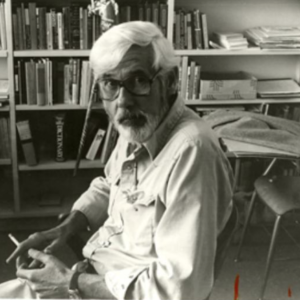
Cresap Watson photographed in his UNO office. From Robert Shenk’s “Carrying On: The First Fifty Years of the UNO English Department,” 2009.

[see Ned Hemard’s excellent “When the Moon Hits Your Eye: Or Pizzas of the Past in New Orleans,” neworleansbar.org. 2018]
♦ ♦ ♦
In an attempt to keep my teaching job, I enrolled in a graduate English class (teaching methods) at the University of New Orleans, taught by Dr. Cresap Watson, a brilliant and kind man whose low-key demeanor made Wednesday night classes a joy. We also gathered after class at Luigi’s nearby: cheap draft beer and, most weeks, the Radiators live.
Cresap, one colleague recalled, “was a great chair [from 1960-64 and 1969-72]; all the English faculty loved and admired Cresap.” Another said, “He was everywhere. Encouraging, inventing, laughing, making you believe that he believed you could do anything, soothing the angry, cajoling the hesitant.”
Nothing worked, though, to keep me employed at Chalmette; the state board of education heard my appeal of being denied a contract for 1981-82 and said I could be re-hired in January ’82 if I would take the fall semester off for a full course load of undergraduate courses that had been determined necessary qualifications: 2 hours of phys. ed; a couple of US history courses, another methods course, a social sciences elective. The board agreed, at my Baton Rouge hearing, that my year of teaching at Chalmette would count for practice teaching, but that was it, “next appeal, please,” and I was out the door.
Still, that class at UNO was so much fun I enrolled in the Greater New Orleans Writing Project, co-taught by Cresap and Keith Veizer, who quickly became a good friend and New Orleans mentor.
Unable to talk C, one of my fellow students in GNOWP, into making a cross-country drive with me (in her new Corvette, actually, instead of my diesel Rabbit), and warned away from a local character whom Keith knew and who wanted badly to be my co-pilot–this fellow claimed friendship with William Burroughs, Jr. and that we would visit with him in Boulder; I didn’t realize WB, Jr. had died in March 1981–I made the drive to Seattle alone, where I was to stay with my friend John Gray and his family, perhaps to find work. For my several weeks of travel, I stopped regularly on alternate Mondays to file unemployment claims, and my mother was meanwhile forwarding the checks to Seattle, where they would await me. I stayed a few nights in Steamboat Springs, with L, whom I’d met at a New Orleans wedding of one of GNOWP classmates, and she was my tour guide until we got to Idaho, where I left her and went on alone to Seattle.
John and I had driven down the coast to Berkeley, to visit Mark Smith-Soto and Beth Adamour (who’d been one of my Quality Crew Chiefs for the census) when I got the phone call from Erwin Hester offering me a job teaching comp at ECU; by the time I got back to New Orleans to close out my apartment, I’d also been offered a similar job at UNO. I thought, however, that one was supposed to honor one’s obligations, a quaint notion, I learned, in modern day academia.
Of course, had I stayed in New Orleans. . . .
1981 Greenville, NC
Soon after moving to Greenville, in August 1981 to begin a one-year appointment at East Carolina University, I discovered the fun and thriving music scene that was centered around the New Deli, the Attic, the Treehouse, JJ’s, and the Rathskellar. The Lemon Sisters and Rutabaga Brothers were one of the most popular bands in the region, and it wasn’t unusual for late night dancers at the Deli to spill out onto Fifth Street. The Amateurs were the other local band that, like the Lemons & Rutas, were good enough to have had a break-out national moment. Bill “Shep” Shepherd was their lead singer and community spirit whose weekly pot-luck suppers at his big rambling home on West Fifth Street were always festive and full of artists and musicians and the kinds of eccentrics that hang around such folks. It was at the New Deli that Shep asked me if he’d ever shown me the old movie that he thought had been made in Greenville, and at one of these pot-lucks that he showed me the actual 35 mm reels, piled up in a hall closet. The reels turned out to be several copies of “Pitch a Boogie Woogie,” in varying degrees of condition, and a reel of advertisements.
Meanwhile, in the English Department, I got re-hired and my contract extended.
1984
Edited two collections of poetry: Dreaming the Blues: Poems from Martin County and (co-edited with Luke Whisnant) Leaves of Greens: the Collard Poems.
During May and June, I traveled with my sister Anne through Spain and Portugal and into Morocco. I drove our rental without scratching it but we had many a close corner turned and got robbed expertly in Seville but enjoyed staying at several paradors and visiting lots of castles, museums, and eating lots of tapas a bit before they became the rage. In Madrid, especially, certain bars were lavish in their presentations, and I was fortunate that friends Mark Smith-Soto and Beth Adamour were in that grand city for the summer. Mark, a native Spanish-speaker, laughed when I told him about Anne’s having gotten disgusted at a famous country restaurant in Chinchon when she turned a bit of her barbecued rabbit dish over to reveal a little skull severed cleanly down the middle, half of two sets of little teeth gleaming through the gravy. (She became a vegetarian for the duration of our travels and then had trouble with bad shrimp in Tangier that kept her from accompanying me on a visit with Paul Bowles.) Mark grew up in D.C. and in Costa Rica where he had heard an expression of trickery that basically translated as “I fed you what you thought was a rabbit but it was really a dog!” Our restaurant proprietors were only trying to show Anne, he explained, that she’d truly gotten rabbit, which I very much enjoyed.
1986
Began restoration work and research on “Pitch a Boogie Woogie”
1988
Wrote and co-produced (with Susan Massengale) the UNC-TV documentary Boogie in Black and White.
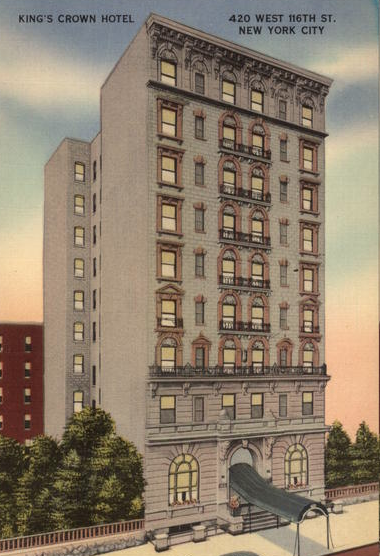
Home for a week, 420 W. 116th St. 2F
1989
March. For a Southern Regional Education Board travel-to-collections grant, I stayed a week in New York, across the street from Columbia University in an apartment building also known as the King’s Crown Hotel. My primary target was Columbia’s Berg, which housed a large collection of Kerouac’s correspondence.
After a week of research, Elizabeth arrived by train for a long weekend. We met Savion Glover and fetched supper for Bunny Briggs and his wife, Olivette Miller; Glover and Briggs were starring in Bring in da Noise, Bring in da Funk. We got back stage after a Saturday matinee courtesy of Barbara Kukla, who had visited me to gain an introduction to Katie Abraham. Barbara was intrigued with the legendary Princess White and had seen a photo of that grand singer with the Silas Green from New Orleans show in an article of mine, and she was thrilled to know that Katie, who owned that photo, was still living in Wilmington and open to meeting her. Barbara was a Newark-based journalist and community historian and also friends with Savion’s mother. Olivette was incredulous that I could talk to her about her less famous brother, Irvin C., whose Brown Skin Models had been featured in “Pitch a Boogie Woogie.” She said all anyone ever wanted to talk to her about was Flournoy. I hadn’t realized Irvin C. had been married to Blanche Thompson, and she remembered several other of the Models. I learned that she had established her own career as a jazz harpist in the 1950s. She and Bunny ordered two coffees with 1 cream and sugar, a fish sandwich, a chicken salad, and a vegetable soup from a nearby deli “beside the Chinese restaurant” but I took no other notes from our visit. Bunny was delighted with the attention I was giving his wife, and Ruth Brown kept walking by their dressing room, where we visited, looking in to see what all the commotion was with our collective catching up on the Miller family but she never paused long enough to speak.
Later that night, Barbara took us to a Newark jazz club in someone’s basement; Amiri Baraka might be there, she said, but he wasn’t, and we were too late for the band. On Sunday, she drove us out to Brooklyn to visit with Sheldon Harris, whom I’d been corresponding with about his book on Clyde Bernhardt and also his interest in black traveling vaudeville shows. He had several original Silas Green from New Orleans show cards and traded me one for something I had collected, and I wonder what.
June 20. Rode on an elevator with Eudora Welty in the U.S. Capitol building.
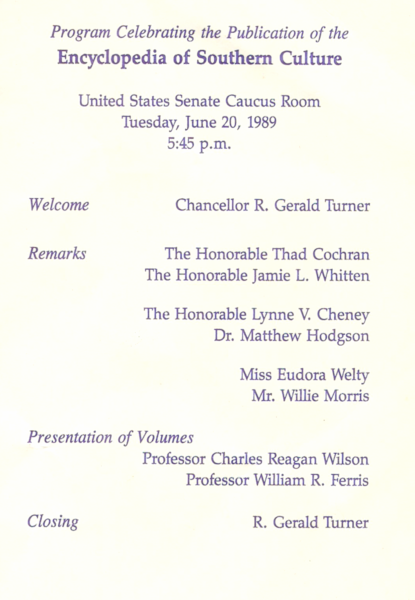 Welty was one of the two guest speakers at the publication party for the Encyclopedia of Southern Culture, in which I was publishing a piece on collard greens. Welty and Willie Morris were to present the literary remarks at the event. I was headed up in an empty elevator that stopped on the second floor; Ms. Welty stepped in, clutching her purse-that-matched-her-shoes (a light green, I want to say), and we nodded slightly at each other before looking away. At the third floor, I of course motioned for her to precede me into the hall outside the Senate Caucus Room, where our event was to be held, and the din of it swallowed up our moments of silence together.
Welty was one of the two guest speakers at the publication party for the Encyclopedia of Southern Culture, in which I was publishing a piece on collard greens. Welty and Willie Morris were to present the literary remarks at the event. I was headed up in an empty elevator that stopped on the second floor; Ms. Welty stepped in, clutching her purse-that-matched-her-shoes (a light green, I want to say), and we nodded slightly at each other before looking away. At the third floor, I of course motioned for her to precede me into the hall outside the Senate Caucus Room, where our event was to be held, and the din of it swallowed up our moments of silence together.
♦ ♦ ♦
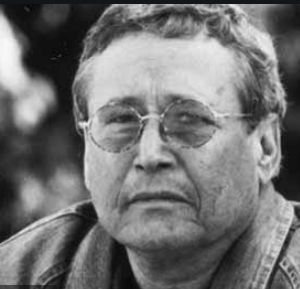
Barry Hannah portrait, from Grove Atlantic
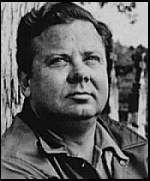
Willie Morris, from the Mississippi Writers Page maintained by Ole Miss
A few years later, I would nearly meet Willie Morris at a sequence of bars in Oxford, Mississippi, but didn’t, because I thought he was a drunken Barry Hannah, whom I sort of stalked as he made some late night rounds, warmly greeted at each stop. I had detoured to Oxford en route from New Orleans back to North Carolina, thinking it would be great fun to find Faulkner’s grave, but prior to going on that quest, I stopped for a beer, where I spotted the white-jacketed “Hannah,” and subsequently watched him drink, from a couple of bar stools away, and engage in familiar talk wherever he went. When I read Morris’s obituary a few years later and saw his photo, I realized with a sudden sickening my mistake, which was worsened by some of what I read in that obituary, how Morris loved to show folks Faulkner’s grave. But somehow, that night, I never found the right moment to break their locals time together in what had seemed like a comfortable routine.
1991
Named founding editor of the North Carolina Literary Review
1993
While the second NCLR was at press, I was in New Orleans at Jazz Fest, having left my office (and the computer with the issue files on it) in charge of an assistant editor, Jane Ashford, a lovely going-back-to-school now-that-the-kids-are-all-grown kind of lady, smart, meticulous and efficient, proper, pleasant, a sharp dresser and model citizen. My brand new office computer had a cool voice command you could use to make it speak in your own recorded voice when you made a mistake, so instead of a little beep or mechanical sound when you made an invalid touch on your keyboard, mine would say, in my loud recorded voice, “F*ck, s*it, what the h*ll is going on?” Somehow this seemed funny when I installed it, just before leaving for New Orleans. I had a fantastic office in what we called Austin City Limits, a cute little old-brick building that had first been the university’s laundry (with a drive up window through which I could watch the Big House, where the rest of the English Department hived) and then its police department (mine had been the chief’s office, long, spacious, old wood, big windows on two walls, the other two lined with tall bookshelves) before being ceded to English. Jane had her own computer in this office complex, so while I was gone for a few days, there’d be no reason for mine to even be turned on.
Another editorial assistant, Tim Hampton, was also a writer for a local lit rag, and he wrote a pre-release story about how great the new NCLR was going to be, and it came out on the second Friday of Jazz Fest. One of the book review essays in that forthcoming issue of NCLR was by Sparrow, the East Greenwich Village poet and activist who’s now living in the Catskills. He was an old pal of Adam Schonbrun, also a poet and a new colleague of ours at ECU, and through Adam I had gotten Sparrow to respond to recent poetry collections by Michael Chitwood (Saltworks) and William Boyd (Poetic Penguins). Tim loved Sparrow’s eccentric review and somehow managed to get into his article mention of Sparrow’s having entered a bad poetry contest with a submission titled “Why I Pick My Nose,” including a few lines of it quoted. It also just so happened that our DEAN was named Sparrow, Wendell Keats Sparrow to be exact, a usually jolly but sometimes insecure fellow who had first conceived of NCLR and given its editorship to me. He had busts of both Robert E. Lee and Faulkner on his mantel and had once asked me earnestly to explain to him what exactly a roman a clef was, he’d been hearing so much about it lately. So when Dean Sparrow read Tim’s review, he somehow imagined that we were publishing a satire about him, ascribing authorship of a nose-picking poem to him, Sparrow, without even calling him Dean. And o did Dean simmer. He was outside the Big House office waiting, at 8 a.m. Monday morning, when the first secretary came in, and she had to immediately call Jane, my office keeper, to come in to work and help Dean find the issue file so that he could see exactly how mean we had been to him, with, as she’d report later, a grumbling insistence that the press was going to be stopped, and they went to my office where the very nervous Jane repeatedly made mistakes trying to find the right issue and then the right file, all the while Dean listening to me say F*ck s*it what the h*ll is going on? Finally she found Sparrow’s review and gave Dean my nice old swivel office chair from which to read it, and he soon enough realized his foolishness, that it was New York poet Sparrow and not Kinston Dean Sparrow who had picked his nose and admitted it in a bad poem, blushed and stammered and made her promise to never reveal to me what had just transpired.
On my return from Jazz Fest, I was coming out of the Big House English office when I saw Jane far down the long hall and she came running with a story that had to be told.
1995
May. Irwin Kremen’s got his hands in chokehold position as he says to our art director, “I oughta strangle you, young man.”
We’re at press for cover proofs for a Black Mountain College special issue of the North Carolina Literary Review. May 1995. It’s our fourth issue but the first to be produced on computer-driven presses, and as we arrived, their low hum-and-churn filled the cavernous and brightly lit pressroom at Walker-Ross as we gathered around one machine to test our cover.
Soon enough, though, all work has ceased, the other machines turned off, and ours on pause. Stanton Blakeslee, who designed the cover —it features a beautiful image of one of Krem’s collages made from scrap paper, “La Villerna”—has been patiently watching as Krem discards one freshly printed cover after another: too brown, too orange, not black enough. No one’s asking how expensive this is becoming as full color pages–on cover stock!–gather on the floor beside the press; we’re all just wanting Krem to be pleased. At first it had been just him, Stanton and me, the pressman and his boss, but as the pile of rejected covers has grown, so has our audience, now a dozen, all watching and waiting to see when Krem will be satisfied.
And finally he is.
But as the pressman is locking in the mix of inks and we’re all feeling easy at last, Krem has kept hold of that finalized cover, studying it. “But it’s crooked,” he finally announces. “Let’s run it again.”
Stanton, a burly but amiable fellow, long dirty-blond hair and bright blue eyes, is in truth associate art director, still an undergrad, not yet 21. But today he’s in charge of this last step before we can get going on our many-times delayed project. He doesn’t miss a beat: “How can you tell?” he asks drily.
Krem’s quick rage is nearly palpable.
His chokehold freezes, at the end of his threat, within two inches of Stanton’s throat, thumbs not quite touching but fingers all wide and extended, ready to grasp as he threatens to strangle him. Stanton, though, calmly replicates the move, looking down narrow-eyed at Krem as he says, his own hands now in chokehold pose–the two of them look almost like they could be slow-dancing–“Yeah, and I’ll strangle you right back, old man.”
[this was the original first section of my essay for the Appalachian Journal‘s Black Mountain College issue (2018); its title then was “And I’ll Strangle You Right Back, Old Man.” After this section was cut, it became “We Were All Famous, You Just Didn’t Know It.”
1999
Our son, Silas James Albright, born at Pitt Memorial Hospital, Greenville, 9-9-99
2001 Fountain / Greenville
We moved to Fountain, after restoring the old R.A. Fountain house.
2004
With Elizabeth, opened R.A. Fountain, General Store & Internet Cafe, while I continued to teach at ECU.
2018 Fountain
Retired from ECU. Bought a smart car and a smart phone and learned what all the fuss about Bluetooth was. Got talked into running for Pitt County Commissioner and was elected.